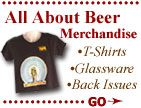
| ||||
| AAB Departments |
| ...Beer Features |
| ...Beer Talk |
| ...Pull Up A Stool! |
| ...What's Brewing |
| ...Beer Travelers |
| ...Stylistically Speaking |
| ...Beer & Food |
| ...Homebrewing |
| ...Collectibles |
| ...Marketplace |
| Beer Lovers' Resources |
| ...World Beer Festival |
| ...Brew Cruise Info |
| ...AAB Merchandise |
| ...AAB Bookstore |
| ...Beer Links |
| About the Magazine |
| ...Subscription Info |
| ...Retail the Magazine |
| ...Advertising Info |
| ...Contact AAB |

|
All About Beer Magazine
Volume 23 Number 4
September 2002
Beer Glassware
by Dave Gausepohl
 I can see clearly now that the beer is gone.
I can see clearly now that the beer is gone.
Early drinking vessels included earthenware, crockery, wood, and even scraps of leather sewn together and lined with pitch. These crude containers served the purpose but obscured the visual image of a beer.
Perhaps it's no coincidence that some of the best brewing regions of the world have also been major glass producing regions. The term "pale ale" comes from the fact that these were the first filtered beers. Because the coarse, chunky items were filtered out, this ale took on a paler, more appealing hue.
The idea of filtration coincided with the development of glassware. Now that consumers could see what they were drinking, it was time for the beers to go through a cosmetic upgrade. Beer styles--like pilsner--that were developed after the availability of glassware have mostly been bright in appearance. Consumers shunned unfiltered beer, making this style the predominant beer of choice the world over.
The Glass Fits the Style
Glass plays an important role in the appreciation of the beer. Highly effervescent brews like hefeweizen require a tall glass that flares out at the top. The shape serves two purposes: it allows some of the carbonation to escape, and it allows the aroma to be better enjoyed.
Beer glasses have experienced a number of transformations over the years. Bruce Marks, a collector of beer glassware, designed a system for cataloging the various shapes and sizes produced by the US glassmakers. His task involved classifying hundreds of varieties of shapes and sizes.
The glass of choice in the United States has to be the 16-ounce mixing glass. This tapered shaped glass, affectionately known as the pint, was first produced to fit the top of the stainless steel martini mixer or shaker. Bartenders quickly made this glass popular because it is durable and it stacks to save storage space.
The stemmed beer glass is also a favorite of the bartender because it can be hung by its base. Mugs, another popular type of beer glass, can be hung by their handles. Unusual beer glass styles include the fishbowl, the hourglass, the chalice, the boot, and the barrel glass. One of the most unusual shapes is the thistle glass for Scotch ales.
European glassware is even more elaborate and varied. In most cases, each brewery has its own patented signature design. In Belgium, if your beer is served in the wrong glass, you are allowed to send it back. Just like the vast variety of Belgian beers, there seems to be an endless variety of Belgian beer glassware.
Glasses for Beer Advertising
Early beer advertising glasses were embossed and rather heavy. Some such glassware is trimmed in gold or silver. An acid etching process was developed to apply ornate advertisement for the beer. Some of these designs were true works of art, and some even included detailed etchings of the breweries. Eventually, artisans learned how to fire enamel paint onto the glassware, enabling placement of color advertising on the glass. Amazingly, even though they were produced more recently, some of the rarer beer glasses are of this enamel variety.
Glassware was a great way for the breweries to provide a loyalty prize to the taverns when it was illegal to give away the beer or other rewards. Many of today's micros and beer bars host pint nights, during which, for a nominal fee, you not only get to enjoy a great brew, but you get to take the glass home with you.
One suggestion for serving beer is NOT to serve it in a frosted glass. The frosting process applies the flavors and aromas of the freezer to the glassware and it masks the flavor of the beer.
Pouring your beer into a glass, instead of drinking from the can or bottle, is a great practice. It allows the beer to breathe, improving the flavor, and it enhances your enjoyment of the aroma as well. It also gives you a chance to appreciate the visual appeal of the nectar of the gods.
----------------------------
Beer Dave Gausepohl has collected breweriana since 1974 and has a personal collection of over 400,000 items. He has visited over 1,000 breweries and tasted well over 10,000 different brews from the world over.









